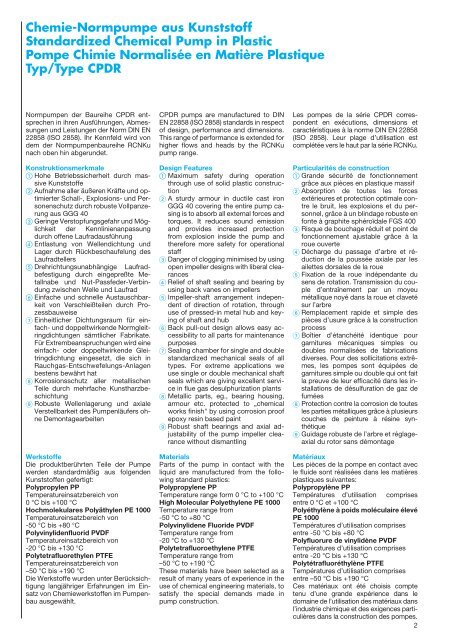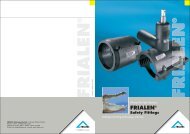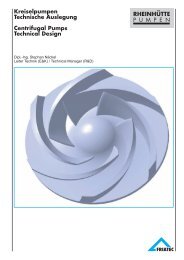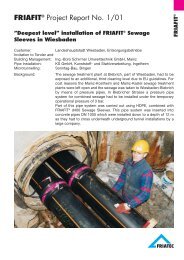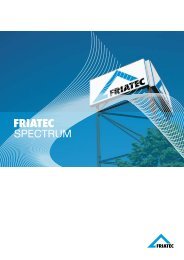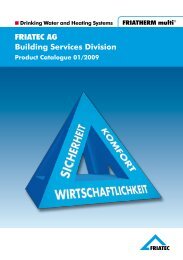Chemie-Normpumpe aus Kunststoff Standardized ... - Friatec
Chemie-Normpumpe aus Kunststoff Standardized ... - Friatec
Chemie-Normpumpe aus Kunststoff Standardized ... - Friatec
You also want an ePaper? Increase the reach of your titles
YUMPU automatically turns print PDFs into web optimized ePapers that Google loves.
<strong>Chemie</strong>-<strong>Normpumpe</strong> <strong>aus</strong> <strong>Kunststoff</strong><br />
<strong>Standardized</strong> Chemical Pump in Plastic<br />
Pompe Chimie Normalisée en Matière Plastique<br />
Typ/Type CPDR<br />
<strong>Normpumpe</strong>n der Baureihe CPDR entsprechen<br />
in ihren Ausführungen, Abmessungen<br />
und Leistungen der Norm DIN EN<br />
22858 (ISO 2858). Ihr Kennfeld wird von<br />
dem der <strong>Normpumpe</strong>nbaureihe RCNKu<br />
nach oben hin abgerundet.<br />
Konstruktionsmerkmale<br />
Hohe Betriebssicherheit durch massive<br />
<strong>Kunststoff</strong>e<br />
Aufnahme aller äußeren Kräfte und optimierter<br />
Schall-, Explosions- und Personenschutz<br />
durch robuste Vollpanzerung<br />
<strong>aus</strong> GGG 40<br />
Geringe Verstopfungsgefahr und Möglichkeit<br />
der Kennlinienanpassung<br />
durch offene Laufrad<strong>aus</strong>führung<br />
Entlastung von Wellendichtung und<br />
Lager durch Rückbeschaufelung des<br />
Laufradtellers<br />
Drehrichtungsunabhängige Laufradbefestigung<br />
durch eingepreßte Metallnabe<br />
und Nut-Passfeder-Verbindung<br />
zwischen Welle und Laufrad<br />
Einfache und schnelle Aust<strong>aus</strong>chbarkeit<br />
von Verschleißteilen durch Prozessbauweise<br />
Einheitlicher Dichtungsraum für einfach-<br />
und doppeltwirkende Normgleitringdichtungen<br />
sämtlicher Fabrikate.<br />
Für Extrembeanspruchungen wird eine<br />
einfach- oder doppeltwirkende Gleitringdichtung<br />
eingesetzt, die sich in<br />
Rauchgas-Entschwefelungs-Anlagen<br />
bestens bewährt hat<br />
Korrosionsschutz aller metallischen<br />
Teile durch mehrfache Kunstharzbeschichtung<br />
Robuste Wellenlagerung und axiale<br />
Verstellbarkeit des Pumpenläufers ohne<br />
Demontagearbeiten<br />
Werkstoffe<br />
Die produktberührten Teile der Pumpe<br />
werden standardmäßig <strong>aus</strong> folgenden<br />
<strong>Kunststoff</strong>en gefertigt:<br />
Polypropylen PP<br />
Temperatureinsatzbereich von<br />
0 °C bis +100 °C<br />
Hochmolekulares Polyäthylen PE 1000<br />
Temperatureinsatzbereich von<br />
-50 °C bis +80 °C<br />
Polyvinylidenfluorid PVDF<br />
Temperatureinsatzbereich von<br />
-20 °C bis +130 °C<br />
Polytetrafluorethylen PTFE<br />
Temperatureinsatzbereich von<br />
–50 °C bis +190 °C<br />
Die Werkstoffe wurden unter Berücksichtigung<br />
langjähriger Erfahrungen im Einsatz<br />
von <strong>Chemie</strong>werkstoffen im Pumpenbau<br />
<strong>aus</strong>gewählt.<br />
CPDR pumps are manufactured to DIN<br />
EN 22858 (ISO 2858) standards in respect<br />
of design, performance and dimensions.<br />
This range of performance is extended for<br />
higher flows and heads by the RCNKu<br />
pump range.<br />
Design Features<br />
Maximum safety during operation<br />
through use of solid plastic construction<br />
A sturdy armour in ductile cast iron<br />
GGG 40 covering the entire pump casing<br />
is to absorb all external forces and<br />
torques. It reduces sound emission<br />
and provides increased protection<br />
from explosion inside the pump and<br />
therefore more safety for operational<br />
staff<br />
Danger of clogging minimised by using<br />
open impeller designs with liberal clearances<br />
Relief of shaft sealing and bearing by<br />
using back vanes on impellers<br />
Impeller-shaft arrangement independent<br />
of direction of rotation, through<br />
use of pressed-in metal hub and keying<br />
of shaft and hub<br />
Back pull-out design allows easy accessibility<br />
to all parts for maintenance<br />
purposes<br />
Sealing chamber for single and double<br />
standardized mechanical seals of all<br />
types. For extreme applications we<br />
use single or double mechanical shaft<br />
seals which are giving excellent service<br />
in flue gas desulphurization plants<br />
Metallic parts, eg., bearing housing,<br />
armour etc. protected to „chemical<br />
works finish" by using corrosion proof<br />
epoxy resin based paint<br />
Robust shaft bearings and axial adjustability<br />
of the pump impeller clearance<br />
without dismantling<br />
Materials<br />
Parts of the pump in contact with the<br />
liquid are manufactured from the following<br />
standard plastics:<br />
Polypropylene PP<br />
Temperature range form 0 °C to +100 °C<br />
High Molecular Polyethylene PE 1000<br />
Temperature range from<br />
-50 °C to +80 °C<br />
Polyvinylidene Fluoride PVDF<br />
Temperature range from<br />
-20 °C to +130 °C<br />
Polytetrafluoroethylene PTFE<br />
Temperature range from<br />
–50 °C to +190 °C<br />
These materials have been selected as a<br />
result of many years of experience in the<br />
use of chemical engineering materials, to<br />
satisfy the special demands made in<br />
pump construction.<br />
Les pompes de la série CPDR correspondent<br />
en exécutions, dimensions et<br />
caractéristiques à la norme DIN EN 22858<br />
(ISO 2858). Leur plage d’utilisation est<br />
complétée vers le haut par la série RCNKu.<br />
Particularités de construction<br />
Grande sécurité de fonctionnement<br />
grâce aux pièces en plastique massif<br />
Absorption de toutes les forces<br />
extérieures et protection optimale contre<br />
le bruit, les explosions et du personnel,<br />
grâce à un blindage robuste en<br />
fonte à graphite sphéroïdale FGS 400<br />
Risque de bouchage réduit et point de<br />
fonctionnement ajustable grâce à la<br />
roue ouverte<br />
Décharge du passage d’arbre et réduction<br />
de la poussée axiale par les<br />
ailettes dorsales de la roue<br />
Fixation de la roue indépendante du<br />
sens de rotation. Transmission du couple<br />
d’entraînement par un moyeu<br />
métallique noyé dans la roue et claveté<br />
sur l’arbre<br />
Remplacement rapide et simple des<br />
pièces d’usure grâce à la construction<br />
process<br />
Boîtier d’étanchéité identique pour<br />
garnitures mécaniques simples ou<br />
doubles normalisées de fabrications<br />
diverses. Pour des sollicitations extrêmes,<br />
les pompes sont équipées de<br />
garnitures simple ou double qui ont fait<br />
la preuve de leur efficacité dans les installations<br />
de désulfuration de gaz de<br />
fumées<br />
Protection contre la corrosion de toutes<br />
les parties métalliques grâce à plusieurs<br />
couches de peinture à résine synthétique<br />
Guidage robuste de l’arbre et réglageaxial<br />
du rotor sans démontage<br />
Matériaux<br />
Les pièces de la pompe en contact avec<br />
le fluide sont réalisées dans les matières<br />
plastiques suivantes:<br />
Polypropylène PP<br />
Températures d’utilisation comprises<br />
entre 0 °C et +100 °C<br />
Polyéthylène à poids moléculaire élevé<br />
PE 1000<br />
Températures d’utilisation comprises<br />
entre -50 °C bis +80 °C<br />
Polyfluorure de vinylidène PVDF<br />
Températures d’utilisation comprises<br />
entre -20 °C bis +130 °C<br />
Polytétrafluoréthylène PTFE<br />
Températures d’utilisation comprises<br />
entre –50 °C bis +190 °C<br />
Ces matériaux ont été choisis compte<br />
tenu d’une grande expérience dans le<br />
domaine de l’utilisation des matériaux dans<br />
l’industrie chimique et des exigences particulières<br />
dans la construction des pompes.<br />
2


